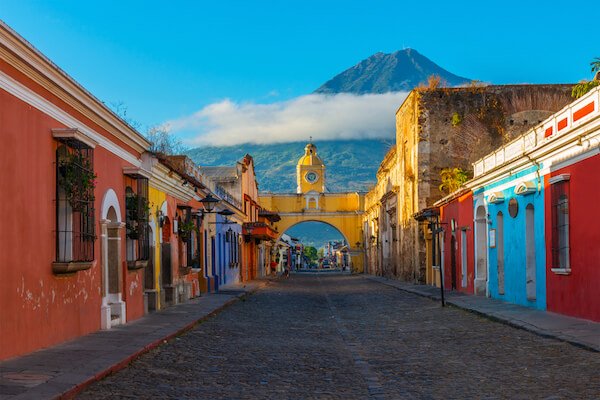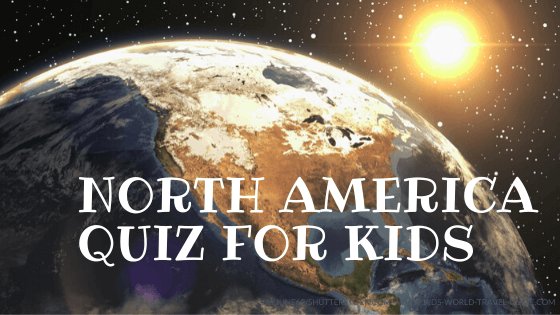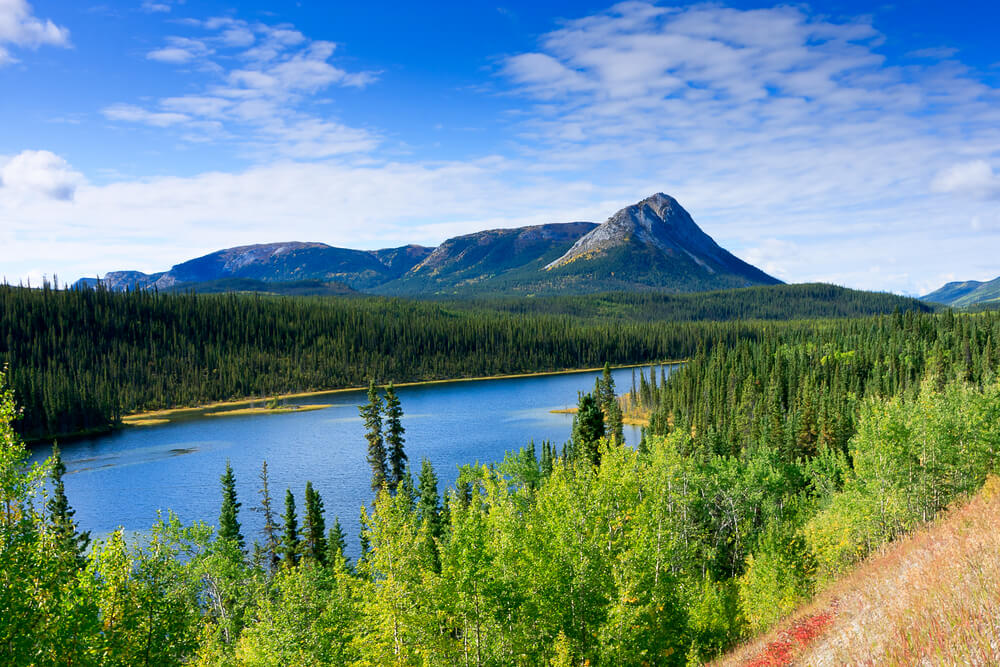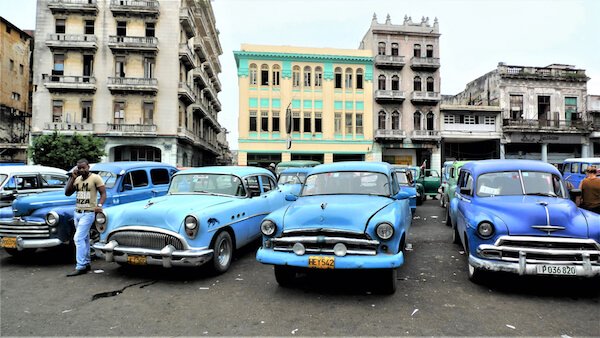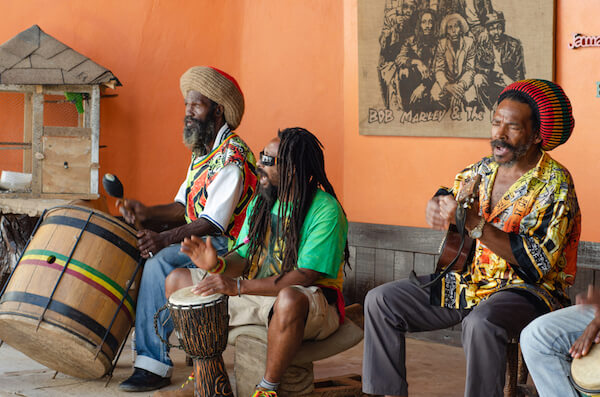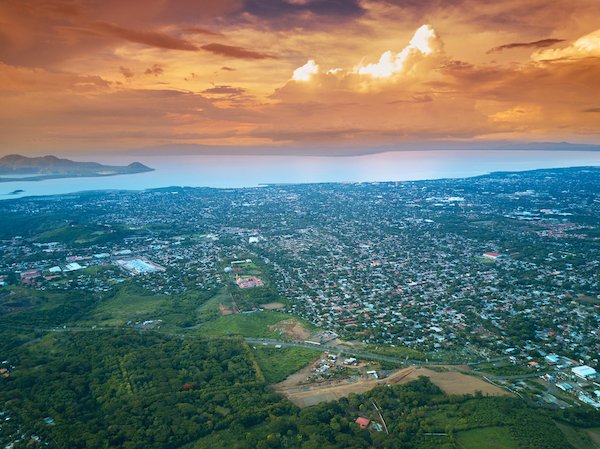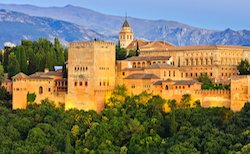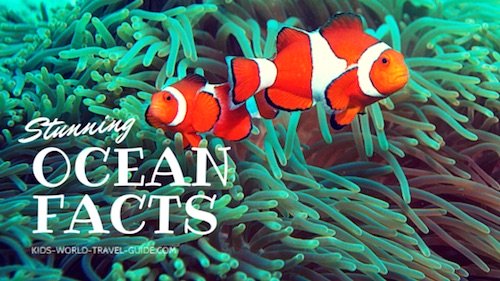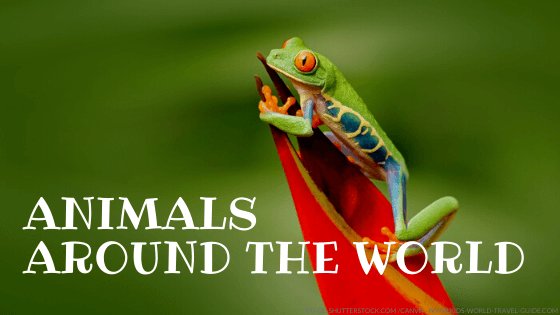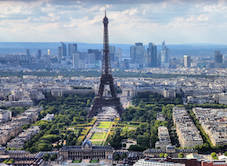- Homepage
- North America
- Costa Rica
Costa Rica Facts for Kids
Interesting Costa Rica Facts

Here are some interesting Costa Rica Facts for Kids which were choosen and reseached by kids especially for kids.
Costa Rica for Kids

- Continent: North America
- Population: 5.3 million people (2025)
- Capital: San José with 1.4 million people
- Name: Republic of Costa Rica
- Official Language: Spanish
- Religion: Most Costa Ricans are Christians (87%)
- Currency: 1 colón, the symbol is (₡) and the smallest coin is 10 colones
- National colours: blue, white and red
- National bird: yigüirro, which is a clay coloured robin
 Yigüirro
Yigüirro- History: Indigenous settlements in the region date back to 10,000 BC. Stone tools were found from the early settlements in the Cartago Province of Costa Rica. Farming and agricultural activities in the area were already conducted about 5,000 years ago, however, the country was then only sparsely inhabited. Christopher Columbus reached the Costa Rican shores in 1502. Costa Rica was a Spanish colony until 1821. Costa Rica gained independence from Spain on 15 September 1821. The country has no army since 1948.
- National Day: 15 September (Independence Day)
- Head of State: The president of Costa Rica is Rodrigo Chaves since 2022. Next elections will be on 1 February 2026.
Costa Rica Map
Where is Costa Rica?
Costa Rica is a country on the North American continent and is one of the seven countries in the region called Central America.
Central America includes these seven countries: Costa Rica, Belize, El Salvador, Guatemala, Honduras, Nicaragua and Panama.
Costa Rica shares a Pacific Ocean and an Atlantic Ocean coastline.
 Map of Costa Rica
Map of Costa RicaAs you can see on the map, Costa Rica borders two countries: Nicaragua in the north and Panama in the southwest of the country. The border with Nicaragua (467 km/ 290 miles) is longer than the border between Costa Rica and Panama (348 km/ 216 miles).
The name Costa Rica originates from the Spanish words for "rich coast". Costa Rica is often considered as the safest country in Central America.
Costa Rica is slightly smaller than the U.S. state of West Virginia/ USA or slightly larger than Slovakia.
Costa Rica Facts | Costa Rica Geography
The landscape is tropical and the country has an extremely rich wildlife.
There are over 100 volcanos in Costa Rica, some of them active such as the Poás Volcano in the Central Highlands that erupted in April 2025.
The highlands of Costa Rica are known for pristine cloud forests. The lush vegetation in the high mountain range is called 'cloud forest' because the clouds stay within the tree canopies of the forest throughout the day. In the misty jungle setting you can admire the many plants, birds, reptile and insect species.
 Monteverde Cloud Forest
Monteverde Cloud ForestCosta Rica is the only megadiverse country in Central America and houses five percent of the existing biodiversity in the entire world.
Deforestation due to cattle farming and expanding agriculture, as well as marine pollution are some of the big challenges the megadiverse country is facing.
Costa Rica Geo Superlatives
- Costa Rica is one of the seventeen megadiverse countries. Although the country is very small, it has a rich biodiversity and houses about 5% of the world’s animal and plant species.
- The highest mountain peak is the Cerro Chirripó at 3,819 m/ 12,529 ft. The name "Chirripó" actually means "land of eternal waters”
- The highest volcano of Costa Rica is the Volcán Irazú. It last erupted in 1965.
 Volcán Irazú
Volcán Irazú- Costa Rica’s longest mountain range is the Cordillera de Talamanca, with 320 km/ 199 miles.
- The longest river of Costa Rica is the San Juan River along the border to Nicaragua.
- The largest island of Costa Rica is the Isla Calero at the border to Nicaragua.
- The largest lake is Lake Arenal which is located at the base of the volcano Arenal.
 Lake Arenal and Volcano Arenal
Lake Arenal and Volcano ArenalCosta Rica Facts
Costa Rica Attractions for Kids
Costa Rica is known as an ecotourism paradise. The country has many attractions to entice the whole family. There are plenty of outdoor activities such as hiking, zip lining, kayaking, cycling, walking over hanging bridges, watersports and relaxing at the fantastic Costa Rican beaches.
 Manzanillo beach
Manzanillo beachHere are some of our favourite Costa Rica attractions for kids:
- San José is Costa Rica’s largest city housing about 20% of the country’s population. There are fascinating museums in the city such as the Jade Museum and the National Museum. Exploring the country can start right in San José as four volcanoes are situated near the capital city, one of them is the volcano called Irazú, the highest volcano of the country.
 San José
San José- Cartago, formerly the capital city of Costa Rica until 1829, is also known as Ancient Metropolí. Every year at the beginning of August, millions of people visit the city as part of their pilgrimage to the "Our Lady of the Angels" Basilica. The basilica is located in the center of Cartago.
 Basilica of Cartago
Basilica of Cartago- Arenal: In the Mistico Hanging Bridges Park you can have fascinating walks over 16 hanging bridges suspended high up in the tree canopies. Here you can do some serious bird watching and enjoy great jungle views.
 Hanging Bridges
Hanging Bridges- Ballena National Marine Park: The national park along the Pacific Ocean coastline is popular for watching humpback whales and dolphin swim by when they visit the area for breeding. Ballena is the Spanish word for "whale". Whales usually can be seen here from July to October.
 Whale
Whale- Corcovado: The national park has one of the most unique ecosystems where one can experience Costa Rica's rich fauna and flora. There are about 500 tree species and over 360 species of birds as well as over 250 species of mammals, amphibians and reptiles. Costa Rica is home to four monkey species, all can be found here and even big cats and tapirs can be seen in this biodiversity hotspot.
 Corcovado National Park
Corcovado National Park- Tamarindo: Costa Rica has some of the most stunning beaches. The Pacific Ocean beaches of Tamarindo are known for amazing surfing conditions. There are plenty of stunning beaches to choose for all kinds of watersports. Nearby Conchal beach is a popular beach for snorkelling and diving. And Playa Grande just north of Tamarindo is home to huge leatherback sea turtles that can be encountered between October and March.
 Tamarindo Beach by Max Herman
Tamarindo Beach by Max Herman- Chirripó National Park: For all who love hiking, this national park is a must. The scenic mountainside includes the country's highest peak. The mountain face is one of the most prominent landmarks of Costa Rica.
 Chirripó National Park
Chirripó National Park- Cocos Island: The island called 'Isla de Cocos' in Spanish is located in the Pacific Ocean, about 550 km/ 342 miles off the coast of Costa Rica. One of the larger islands of Costa Rica, Cocos Island is a national park and not inhabited. This island is considered the southernmost point of the North American continent.
 Cocos island
Cocos islandPlease note that the southernmost point of continental North America is Punta Mariato in Panama.
Costa Rica Facts for Kids | People
Costa Ricans
More than half of the Costa Ricans live in urban areas.
Most people live in and around the capital city San Jose. Costa Ricans, also referred to as "Ticos", are known as very happy and welcoming people.
The motto of the Ticos is "Pura Vida" in English means "pure life" and refers to the relaxed feeling of enjoying life. Often people also greet and wish each other "Pura Vida" when meeting in the street.
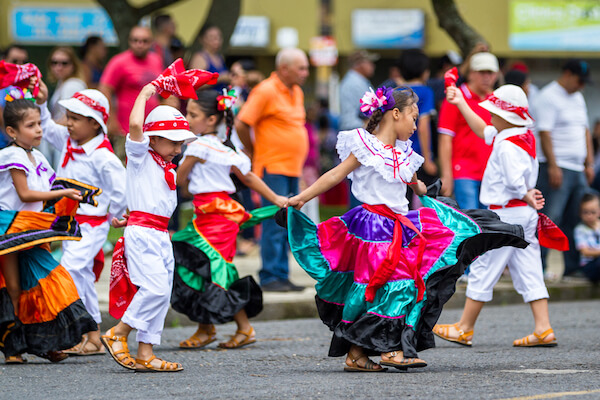 Costa Rican children dancing on Independence Day - image by Wollertz/shutterstock.com
Costa Rican children dancing on Independence Day - image by Wollertz/shutterstock.comIndependence Day in September is celebrated with traditional dances and community parades.
Soccer and basketball are the most popular sports in Costa Rica.
Costa Rica Facts for Kids
Costa Rica Economy
The main agricultural products in Costa Rica are sugar cane, coffee, pineapples, bananas and other fruits.
 Banana trees in a Costa Rican plantation
Banana trees in a Costa Rican plantationThe main trading partners are the USA, China, Mexico, Belgium and Panama.
The main ports of Costa Rica are Puerto Limon and Caldera.
Food in Costa Rica
In Costa Rica, a large variety of fresh fruits and vegetables are sold at the markets.
 Costa Rica market stall
Costa Rica market stallCosta Rican cuisine is varied and the traditional dishes are usually not too spicy. Most dishes contain rice or black beans which are staple foods in the country.
Corn products such as tamales, which are filled wraps made of cornmeal, are served mainly at festive events.
 Chifrijo
ChifrijoTypical Costa Rican dishes:
- Chifrijo: popular street food or snack, containing a bowl of beans, rice and pork cubes, often served with tortilla chips and avocado dip. Chi refers to pieces of fried pork (chicharrón) while frijo refers to the Spanish term frijoles which means beans.
- Casado: The popular dish includes fried plantains, salad and tortillas as well as meat such as chicken, pork or beef and sometimes fish
- Gallo Pinto: traditional breakfast of Costa Rica made of rice and black beans, served with sour cream, tortilla and fried plantain
 Gallo Pinto - traditional Costa Rican dish
Gallo Pinto - traditional Costa Rican dish- Patacones: deep fried flattened plantain rounds, often served with spicy bean sauce or avocado dip
- Yuka frita: fried cassava (often referred to as yuka)
- Arroz con leche: sticky milky rice dessert made with sugar, cinnamon and lemon
- Tres Leches Cake: soft sponge cake made with three types of cream and milk. Leche is the Spanish term for milk.
Costa Rica Facts | Animals in Costa Rica
The manatee is considered the national animal of Costa Rica, as it is represents Costa Rica’s precious marine wildlife.
 Manatee
ManateeThe marine animals are also referred to as sea cows and live in marshy coastal waters. Manatees grow up to 3 m/ 9 ft long and weigh around 500 kg/ 1100 lb. Did you know that baby manatees weigh up to 30 kg/ 66 lb.? This is as big as a nine-year-old child!
There are over 500,000 animal species in Costa Rica. There are almost 900 species of birds.
Costa Rica houses thus more bird species than the USA and Canada combined! One of the endemic species are the colourful toucans that live in Costa Rica and neighbouring Panama only.
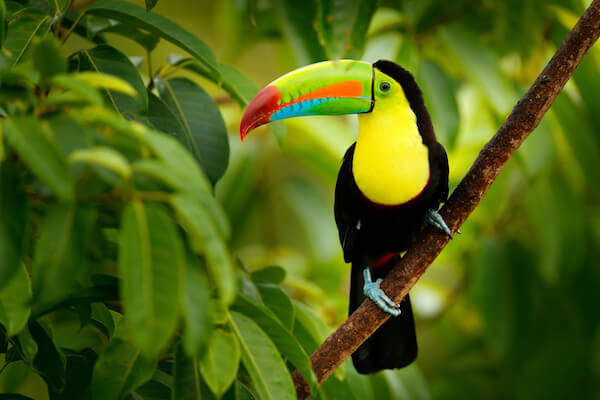 Toucan
ToucanCosta Rica also is home to the world's first sanctuary for sloths. Two of the world's six sloth species are home in Costa Rica.
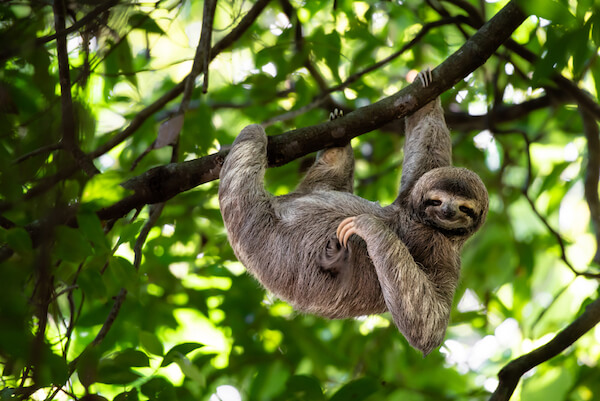 Sloth
Sloth***
We hope you enjoyed reading our Costa Rica Facts for Kids. Make sure to bookmark this page, as we plan to add on more information. Feel free to contact us if your school would like to work on a school project about Costa Rica (animals, food, people, traditions, games, sport etc.) with us.
Popular pages
 Nicaragua Facts Nicaragua Facts |
 Belize Facts Belize Facts |
Costa Rica Facts for Kids | Resources
- The Tico Times. "Poas Volcano Eruption Blankets Costa Rica's Central Valley in Ash." TicoTimes.net. 21 April 2025. Last accessed 25 September 2025
- Pura Vida University. "El Yigüirro" Puravidauniversity. Last accessed 25 September 2025
- Central Intelligence Agency. "Costa Rica." WorldFactBook. Last updated 17 September 2025. Last accessed 25 September 2025
- Essential Costa Rica. "About Costa Rica." VisitCostaRica. Last accessed 25 September 2025
- Costa Rica Tourism. "Ballena National Marine Park." VisitCostaRica. Last accessed 25 September 2025
- Sarah Mayo. "The Complete Guide to Sloths in Costa Rica." CostaRicaExperts. 22 August 2023. Last accessed 25 September 2025
Picture credits on Costa Rica Facts for Kids: Shutterstock.com; Dancing children by Wollertz/shutterstock.com
Return from Costa Rica Facts to Kids World Travel Guide Homepage
Countries in
North America
More about other countries in Central America
 El Salvador
El Salvador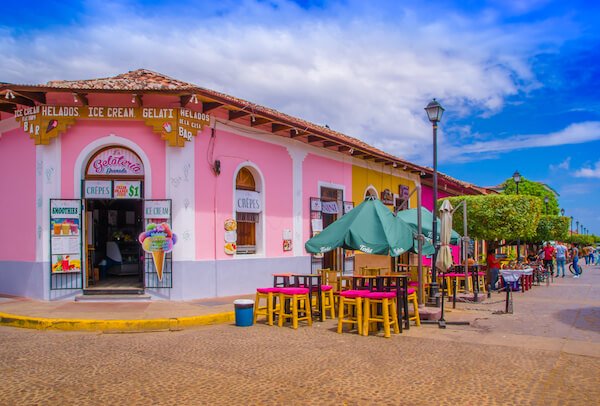 Nicaragua
NicaraguaDid you like what you read?

|
Simply use the html code below. Copy and paste onto your website, blog or Facebook page: <a href="https://www.kids-world-travel-guide.com/costa-rica-facts.html">Kids World Travel Guide: Costa Rica Facts for Kids</a> |




